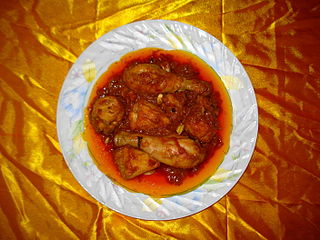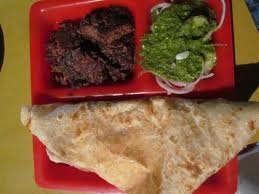
Kebab, kabob, kebap, or kabab is roasted meat that originates from the Middle East and has been popularised by Iranian, Arabic and Turkish cuisine. Many variants of the category are popular around the world, including the skewered shish kebab and the doner kebab with bread.

Korma or qorma is a dish originating in the Indian subcontinent, consisting of meat or vegetables braised with yogurt (dahi), water or stock, and spices to produce a thick sauce or gravy.

Biryani is a mixed rice dish most popular in South Asia. It is made with rice, some type of meat and spices. To cater to vegetarians, in some cases, it is prepared by substituting vegetables for the meat. Sometimes eggs and/or potatoes are added.

Raita is a side dish in Indian cuisine made of dahi together with raw or cooked vegetables, fruit, or in the case of boondi raita, with fried droplets of batter made from besan.

Chelow kabab is an Iranian dish consisting of steamed rice and one of the many varieties of Iranian kebab. It is considered the national dish of Iran, and was probably created by the time of the Qajar dynasty.

Chicken tikka is a chicken dish popularised in the Indian subcontinent popular in India, Bangladesh, Pakistan and the United Kingdom. It is traditionally small pieces of boneless chicken baked using skewers on a brazier called angeethi or over charcoal after marinating in Indian spices and dahi (yogurt)—essentially a boneless version of tandoori chicken. The word tikka is a Persian word, meaning "bits" or "pieces". It is also a chicken dish served in Punjabi cuisine. The Kashmiri version of the dish, however, is grilled over red-hot coals, and does not always contain boneless pieces. The pieces are brushed with ghee at intervals to increase its flavour, while being continuously fanned. It is typically eaten with green coriander and tamarind chutney served with onion rings and lemon, or used in preparing an authentic chicken tikka masala.

Pasanda, also called Parche, is a popular dish from the Indian subcontinent, notably North India, Rampur, Hyderabadi and Pakistani, derived from a meal served in the court of the Mughal emperors. The word is a variation on the Hindi-Urdu word "pasande" meaning "favourite", which refers to the prime cuts of meat traditionally used in the dish.

Kofta is a family of meatball or meatloaf dishes found in Balkan, Middle Eastern, North African, South Caucasian, South Asian and Central Asian cuisines. In the simplest form, koftas consist of balls of minced meat – usually beef, chicken, pork, lamb or mutton, or a mixture – mixed with spices and sometimes other ingredients. The earliest known recipes are found in early Arab cookbooks and call for ground lamb.

Shami kabab or shaami kabab is a local variety of kebab, originating from the Indian subcontinent. It is a popular dish in modern-day Indian, Pakistani and Bangladeshi cuisines. It is composed of a small patty of minced meat, generally beef, but occasionally lamb or mutton, with ground chickpeas, egg to hold it together, and spices. Shami kebab is eaten as a snack or an appetizer, and is served to guests especially in the regions of Dhaka, Deccan, Punjab, Kashmir, Uttar Pradesh and Sindh.

A kati roll is a street-food dish originating from Kolkata, West Bengal, India. In its original form, it is a skewer-roasted kebab wrapped in a paratha bread, although over the years many variants have evolved all of which now go under the generic name of kati roll. Today, mostly any wrap containing a filling enfolded in an Indian flatbread (roti) is called a kati roll. In native Bengali, the word kati roughly translates to 'stick', referring to how they were originally made. In Bengal though, the delicacy is simply known as roll. Kati rolls normally contain coriander chutney, egg, and chicken but the types may vary. Internationally, specifically in parts of Canada and the United States, the kathi roll has become a popular fast food found in Indian take-out restaurants.
Bhojpuri cuisine is a style of food preparation common among the Bhojpuri people of Bihar and eastern Uttar Pradesh in India, and also the Terai region of Nepal. Bhojpuri foods are mostly mild and tend to be less hot in terms of spices used. The cuisine consists of both vegetable and meat dishes.

Mughlai cuisine consists of dishes developed or popularised in the early-modern Indo-Persian cultural centres of the Mughal Empire. It represents a combination of cuisine of the Indian subcontinent with the cooking styles and recipes of Central Asian and Islamic cuisine. Mughlai cuisine is strongly influenced by the Turkic cuisine of Central Asia, the region where the early Mughal emperors originally hailed from, and it has in turn strongly influenced the regional cuisines of Northern India, Pakistan and Bangladesh.
Awadhi cuisine is a cuisine native to the Awadh region in Northern India. The cooking patterns of Lucknow are similar to those of Central Asia, the Middle East, and Northern India and western India with the cuisine comprising both vegetarian and non-vegetarian dishes. The Awadh region has been influenced by Mughal cooking techniques, and the cuisine of Lucknow bears similarities to those of Central Asia, Kashmir, Punjab and Hyderabad. The city is also known for its Nawabi foods.
Bihari cuisine is eaten mainly in the eastern Indian state of Bihar, as well as in the places where people originating from the state of Bihar have settled: Jharkhand, Eastern Uttar Pradesh, Bangladesh, Nepal, Mauritius, South Africa, Fiji, some cities of Pakistan, Guyana, Trinidad and Tobago, Suriname, Jamaica, and the Caribbean. Bihari cuisine includes Angika cuisine, Bhojpuri cuisine, Maithil cuisine and Magahi cuisine.

Pashtun cuisine refers to the cuisine of the Pashtun people and is covered under both Afghan and Pakistani cuisines. It is largely based on meat dishes including mutton, beef, chicken, and fish as well as rice and some other vegetables. Accompanying these staples are dairy products, various nuts, local vegetables, and fresh and dried fruits. Peshawar, Islamabad, Kabul, Bannu, Quetta, Kandhar and Mardan are centers of Pashtun cuisine.

Tikka is a dish consisting of pieces of meat or vegetarian alternatives, with its origins tracing back to the ancient Babylon. The term 'tikka' was given in the mughal era. It is made by marinating the pieces in spices and yogurt, and cooking them in a tandoor. Tikka is popular throughout the Indian subcontinent and also in the United Kingdom.

Chapli kebab or chapli kabab is a Pashtun-style minced kebab, usually made from ground beef, mutton or chicken with various spices in the shape of a patty. The chapli kabab originates from Peshawar in Pakistan. The Peshawari chapli kabab is made with beef and is a popular street food throughout South Asia, including Pakistan, India, Afghanistan and Bangladesh.

Malaysian Indian cuisine, or the cooking of the ethnic Indian communities in Malaysia, consists of adaptations of authentic dishes from India, as well as original creations inspired by the diverse food culture of Malaysia. Because the vast majority of Malaysia's Indian community are of South Indian descent, and are mostly ethnic Tamils who are descendants of immigrants from a historical region which consists of the modern Indian state of Tamil Nadu and Sri Lanka's Northern Province, much of Malaysian Indian cuisine is predominantly South Indian inspired in character and taste. A typical Malaysian Indian dish is likely to be redolent with curry leaves, whole and powdered spice, and contains fresh coconut in various forms. Ghee is still widely used for cooking, although vegetable oils and refined palm oils are now commonplace in home kitchens. Before a meal it is customary to wash hands as cutlery is often not used while eating, with the exception of a serving spoon for each respective dish.

Tunday Ke Kabab, also known as Galouti kebab, is a dish made out of minced meat which has almost become synonymous with the city of Lucknow, India. It is a part of Awadhi cuisine. It is said to incorporate 160 different spices. Ingredients include finely minced buffalo meat, plain yogurt, garam masala, grated ginger, crushed garlic, ground cardamom, powdered cloves, melted ghee, dried mint, small onions cut into rings, vinegar, saffron, rose water, sugar, and lime. Tunday Ke Kabab were introduced to the Nawab of Awadh Wajid Ali Shah. Lucknow’s iconic eating joint Tunday Kababi, started in 1905, is famous for serving buffalo meat galouti kebab.

Karachi cuisine refers to the cuisine found mainly in the city of Karachi, Sindh, Pakistan. It is a multicultural cuisine as a result of the city consisting of various ethnic groups from different parts of Pakistan. Karachi is considered the melting pot of Pakistan.
















